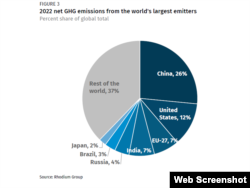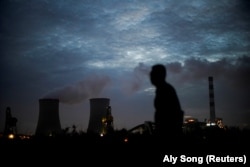Amid COP28, the world’s most important climate meeting held in Dubai, China’s state-linked observer offered flawed analysis to downplay Beijing’s ecological responsibility.
The biggest gathering of world leaders this year, COP28 is an opportunity to revise a goal set eight years ago at COP21 in Paris, when nearly 200 countries pledged to limit global warming to well below 2°C compared to pre-industrial levels.
In China, Victor Gao, vice president of the Center for China and Globalization, a Beijing-based think tank, argued that developed countries historically pollute more and thus bear more responsibility for global warming.
In a piece published on November 30 in China’s state-owned Global Times newspaper, Gao claimed:
“For the developed countries, historically speaking, they have been polluting much more than the developing countries, they should do more to mitigate the climate change impact.”
That is misleading.
There is some truth in it, because emissions released even hundreds of years ago have contributed to global warming today.
Yet the narrative mirrors China’s official position that advanced industrial nations should shoulder the lion’s share of environmental mitigation responsibilities and ignores the fact, that even in historical terms, China is hardly a climate-friendly country.
Between 1850 and 2021 China emitted 284 billion tons of CO2, according to Carbon Brief, a U.K.-based website specializing in climate change policy. That is second after the U.S.’s 509 billion tons during the same period.
The analysis noted that China’s coal-fired economic boom since 2000 is the main cause of its current position.
Moreover, since 2019, China has been emitting more greenhouse gases annually than the entire developed world combined, thus becoming the largest polluter on the planet, the Rhodium Group, a Washington, D.C.-based economic policy think tank reported in 2021.
The think tank’s new estimates indicate that seven economies were responsible for close to two-thirds of global emissions in 2022. China is in first place, emitting 26% of global emissions, followed by the United States at 12% and India at 7%. The European Union countries collectively have also emitted 7% in 2022.
Additionally, even the assumption that China bears less ecological responsibility because it is not a “developed” country is not entirely accurate. China's economic power exploded in the past 40 years, making it the world’s second-largest economy after the United States.
The United Nations ranks countries by a compilation of criteria called HDI or the Human Development Index.
In its latest assessment, the U.N. ranked China’s HDI as “high” placing it 79th among 190 world countries.
The other two top polluters, the United States and India, are ranked 21st and 132nd respectively.
Let’s take a look at what these three countries are doing to meet their emission goals.
China
With heavy investment in renewable energy, China has vowed to peak greenhouse gas emissions by 2030 and achieve carbon neutrality by 2060. Carbon neutrality, or net zero, means not adding to the amount of greenhouse gases in the atmosphere.
Yet that goal is now challenged by extreme temperatures, the worst drought in years and record flooding caused by global climate change.
In 2022, Beijing failed to maintain stable electricity supplies during the hottest days, and, to deal with the blackouts, resumed burning coal to ensure the country’s energy security.
Greenpeace said in August that at least 50.4 gigawatts of new coal power was approved across China in the first half of 2023, equaling permitting two coal power plants per week.
One gigawatt is the equivalent of one large coal power plant, according to Global Energy Monitor (GEM), a San Francisco-based environmental NGO.
GEM says that China currently has 306 coal power plants either being permitted or in construction.
“Continuing to permit more coal capacity will either result in massive emissions increases, or plants sitting idle, generating losses, and perpetuating the power system’s dependence on coal,” said Flora Champenois, a research analyst at Global Energy Monitor.
Climate Action Tracker or CAT, a research group tracking 40 countries’ global emissions, rates China’s overall climate effort highly insufficient, as “the government continues to champion the role of fossil fuels in transitioning its energy sector, with continued increases in fossil fuel production seen as key to providing stability and security.”
New coal-based power plants and integrated steel plants have a typical lifetime of 20-40 years and will lock the sectors further into coal dependency.
The U.S.
The U.S., historically the biggest polluter, is now the world’s second-largest greenhouse gas emitter, emitting about 5.9 billion metric tons of green gas annually.
In 2021, President Joe Biden pledged to reduce U.S. greenhouse gas emissions by 50% to 52% by 2023, more than doubling the country’s prior commitment under the Paris climate agreement. The U.S. aims to hit net zero by 2050.
CAT rates the U.S.’ efforts as insufficient. It says that as of 2022, the U.S. has achieved about one-third of that goal. It notes that the Inflation Reduction Act has mobilized investment into clean energy sectors. This has led to “a more pronounced reduction in emissions until 2030…yet not enough to meet the targeted 50% to 52% reduction below 2005 by 2030.”
Under the Inflation Reduction Act, the United States is poised to invest $370 billion over 10 years into wind, solar, green hydrogen, nuclear energy, and other non-fossil fuel power.
Washington has not built a new coal-fired plant, The New York Times reported. It has cut its coal use by half and is increasing natural gas use instead.
India
In 2021, New Delhi promised to meet half of its energy needs through renewable sources by 2030 and cut its emissions to net zero by 2070.
During his meeting with Biden in June, Indian Prime Minister Narendra Modi said India is the only G20 country that has fulfilled all the promises it made in the Paris agreement.
That’s partly true. According to a 2022 report by Climate Policy Initiative, there’s been a 150% increase in green finance flow since the 2021 pledge, demonstrating “the positive role policy support has had in mobilizing investment.”
CAT also praised India’s significant progress in renewable energy capacity, including policy incentives to develop solar and green hydrogen. Yet it points out that, as with China, India’s reliance on coal power continues to be a drag on its environmental ambitions.
Neshwin Rodrigues, an electricity policy analyst at global energy think-tank Ember, told CNBC that fossil fuels continue to make up 75% of India’s power supply, making it “the only fuel that India has in relative abundance.”
According to data from India’s Ministry of Coal, the country’s coal production rose more than 14% in 2023.
As per its last update in July 2023, the CAT gives India’s climate actions an overall rating of “highly insufficient.” Apart from its reliance on coal, CAT argues that the Indian government’s current plan does not present clear emissions pathways.












